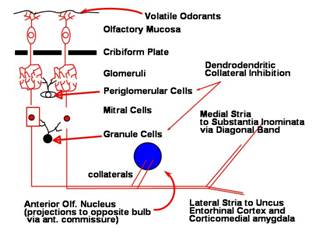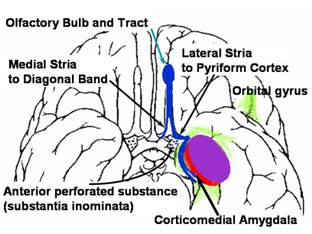Taste and
Olfaction:
Cranial Nerves 7, 9 & 10
Competencies:
- Describe peripheral olfactory innervation and central pathways carrying olfactory information to the forebrain.
- Describe sensory and motor components of cranial nerves 7, 9, and 10.
- Describe peripheral taste receptor cells and taste modalities.
- Describe central connections, second (and possible third) order projections of gustatory and visceral sensory information transmitted via cranial nerves 7, 9, and 10.
To master the material presented in this
lecture:
Read ...
Purves text , Chapter 15
Haines pp 202.
Look at the Review Questions below ...
Listen to the lecture and focus on
the following points ...
Review Cranial Nerves 7, 9 and 10
- It may be easier to remember that each of the cranial nerves carries motor and sensory components associated with either somatic or visceral function:
- extraocular muscles (nerves 3, 4 and 6)
- tongue muscles (nerve 12)
- Branchial motor components (a special category; derived embryologically from branchial arch - nuclei are ventrolaterally displaced from classic motor and sensory columns in the floor of the fourth ventricle)
- muscles of facial expression and stapedius of the inner ear (nerve 7)
- stylopharangeus of the pharynx (nerve 9 arising from the nucleus ambiguus)
- larynx and pharynx (nerve 10 arising from the nucleus ambiguus)
- Visceral motor components
- salivary, parotid, nasal, palatine and lacrimal glands (nerves 7 and 9)
- thorax and abdomen (nerve 10 arising from dorsal motor nucleus of the vagus; cardiac innervation derives from nucleus ambiguus)
- General somatic sensory
- touch, pain from the outer ear (nerves 7, 9 and 10 to spinal trigeminal tract)
Focus on Visceral Afferents
- General visceral sensory (interoception)
- Chemoreceptors - O2, CO2 and glucose levels, and pH
- Carotid bodies and sinus, aortic arch
- Mucosa of pharynx and posterior tongue
- Abdominal chemoreceptors - stomach wall near esophagus and in celiac and hepatic plexuses
- Stretch and pressure receptors
- Aortic arch
- Abdomen
- Larynx and pharynx
- Adrenergic and noradrenergic neurons of the dorsal (nucleus of the solitary tract) and ventrolateral medulla respond to visceral stimuli and mediate physiological and behavioral responses to those stimuli.
- Second order projections from the dorsal and ventrolateral medulla activate autonomic pathways via direct projections to the intermediolateral cell column of the thoracic spinal cord, the dorsal motor nucleus of the vagus and the nucleus ambiguous; as well as rostral projections to the pontine reticular formation (locus coeruleus, parabrachial nucleus), hypothalamus, midline and intralaminar thalamic nuclei, basal forebrain, amygdala and insular cortex.
Taste
- Taste is included in Cranial nerves 7, 9 and 10:
- The receptors (transducers) for taste are epithelial cells in the tastebuds.
- The tastebuds are on papillae of the tongue.
- The receptor cells are innervated by cranial nerves 7, 9 and 10. N7 innervate the anterior two-thirds of the tongue; N9 innervates the posterior third of the tongue.
- The neurally encoded sensations of taste are carried to the CNS by sensory axons, whose pseudounipolar cell bodies are in a ganglion of each nerve. The central process of these neurons enters the brain stem and synapses in nucleus solitarius of the medulla.
- The neurons of nucleus solitarius send their axons to the most medial and basal portion of the VPM of thalamus. Neurons of the VPM project axons to cortex near the tongue representation on somatosensory cortex. Potential secondary projections to the reticular formation, hypothalamus and amygdala integrate taste with olfactory function and provide the anatomical substrates for the motivational aspects of taste and feeding behaviors.
Olfactory System
- Olfactory information is received by specialized olfactory endothelial cells within the olfactory epithelium whose thin axons bundle to pass through the cribiform plate to synapse with the dendrites of mitral cells in glomeruli located in the outer layers of the olfactory bulb. These primary olfactory axons are replaced every thirty to sixty days.
- The olfactory neurons' tiny axons aggregate into bundles to go through the cribriform plate and synapse in the Olfactory Bulb (a part of the CNS).
- Mitral cells send their axons into the central nervous system via the olfactory tracts which lie on the ventral surface of the frontal cortex just lateral to the gyrus rectus.
- Collaterals of mitral cells axons innervate neurons of the accessory olfactory nucleus which send axons to the contralateral olfactory bulb via the anterior portion of the anterior commissure. Interactions of these collaterals with periglomerular and granule cells provide for the collateral inhibition of the mitral cells.
- The olfactory tract bifurcates upon reaching the anterior perforated substance to form the lateral olfactory stria which enters the pyriform cortex (uncus), and the medial olfactory stria which enters the substantia inominata.
- A small but important component of the spinal trigeminal system is also found in the olfactory mucosa. Sensation of acrid or irritating stimuli (e.g. ammonia) is carried by the trigeminal nerve to the spinal trigeminal nucleus.
 Olfactory input from the lateral olfactory stria synapses upon neurons of the pyriform and entorhinal cortex (around the uncus) and corticomedial amygdala forming the primary olfactory receptive area. Direct projections to the infraorbital cortex (primary olfactory cortex) make the olfactory system unique in that olfactory sensory information does not need to pass through the thalamus before reaching neocortical representation. Olfactory input from the lateral olfactory stria synapses upon neurons of the pyriform and entorhinal cortex (around the uncus) and corticomedial amygdala forming the primary olfactory receptive area. Direct projections to the infraorbital cortex (primary olfactory cortex) make the olfactory system unique in that olfactory sensory information does not need to pass through the thalamus before reaching neocortical representation. - Tertiary connections to hippocampus and amygdala drive the behavioral responses to the external sensations (drive for food, reproduction, escape from danger), and to the dorsomedial nucleus of thalamus which sends axons to orbital gyri where conscious perception allows discrimination between odors.
Consider the Following Questions ...
- The reticular formation of the brain stem is known to contain "vital centers" for respiration and cardiovascular control. In general, where are these "centers", and through which cranial and spinal nerves would they exert their effects?
- Afferent innervation of the carotid body is through which cranial nerve, and will affect cardiovascular function through which nerves?
- Where are the cortical areas for processing olfactory information? Identify the nerves carrying taste information, and discuss the central connections for taste in the medulla. How do olfactory signals reach amygdala?
- Describe the pathways for information flow upon smelling a strong odor for natural gas which leads you to become fearful, and as a result break into a sweat.
|